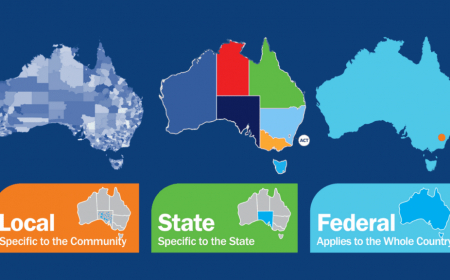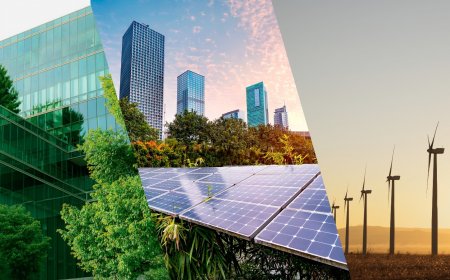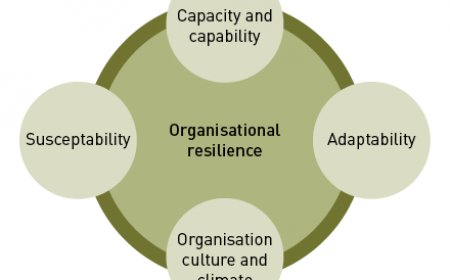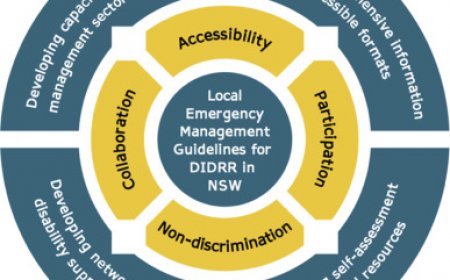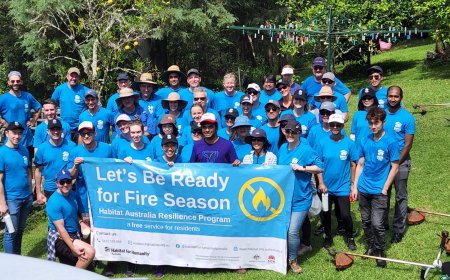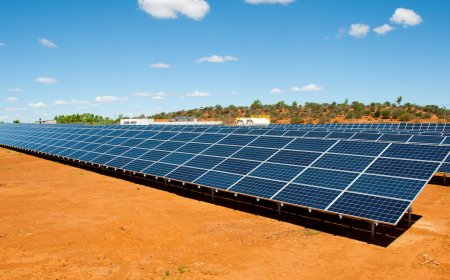Australia National Security: Whats Changing in 2025
Discover how Australia is transforming its national security landscape by 2025, covering geopolitics, technology, climate action, and more. Stay informed about the latest developments shaping the nation’s future.
In recent years, the global security environment has undergone significant transformations, and Australia is no exception. As we approach 2025 , the nation is preparing for a series of profound changes that will redefine its national security strategies, policies, and operational frameworks. These shifts are driven by emerging geopolitical tensions, technological advancements, climate change impacts, and evolving domestic challenges. Understanding these changes is not only crucial for policymakers but also for citizens, businesses, and international stakeholders who rely on Australia's stability and resilience.
The Australian government has taken bold steps to address these multifaceted threats by introducing comprehensive reforms aimed at strengthening its defense capabilities, cybersecurity measures, counter-terrorism efforts, and disaster response systems. This article delves into the intricate details of what is changing in Australia’s national security landscape by 2025, offering insights into how these developments will shape the country’s future.
Geopolitical Shifts and Their Impact on Australian Security
Rising Tensions in the Indo-Pacific Region
The Indo-Pacific region has become a focal point of global power dynamics, with increasing competition among major players such as China, the United States, India, and Japan. For Australia, this heightened rivalry presents both opportunities and risks. The nation’s geographic position places it at the heart of this strategic theater, making it imperative to recalibrate its foreign policy and defense posture accordingly.
By 2025 , Australia aims to bolster its military presence in key areas like the South China Sea and the Pacific Islands. Collaborations with allies through initiatives such as the AUKUS partnership (Australia-United Kingdom-United States) underscore the importance of collective security arrangements. Under AUKUS, Australia is set to acquire nuclear-powered submarines, enhancing its maritime deterrence capabilities significantly. This move reflects a broader strategy to counterbalance China’s growing influence while ensuring regional stability.
Details of the AUKUS Agreement
The AUKUS agreement marks a historic milestone in Australia’s defense history. By acquiring nuclear-powered submarines, Australia will gain unprecedented stealth, endurance, and strike capabilities. These submarines will operate alongside conventional vessels, forming a hybrid fleet designed to patrol vast maritime zones effectively. Training programs for naval personnel are already underway, with experts from the UK and US providing technical expertise. Additionally, AUKUS includes provisions for sharing advanced technologies, such as hypersonic missiles and quantum computing, further solidifying Australia’s role as a technologically advanced military power.
Implications for Regional Diplomacy
While AUKUS strengthens Australia’s ties with Western allies, it has also sparked concerns among neighboring countries. Some Southeast Asian nations fear an escalation of arms races in the region, potentially destabilizing fragile diplomatic relationships. To mitigate these fears, Australia is engaging in multilateral dialogues through forums like ASEAN (Association of Southeast Asian Nations). By promoting transparency and emphasizing peaceful intentions, Australia seeks to reassure its neighbors while safeguarding its own interests.
Economic Security and Supply Chain Resilience
Beyond traditional military concerns, economic security has emerged as a critical component of Australia’s national security agenda. Disruptions caused by the COVID-19 pandemic highlighted vulnerabilities in global supply chains, prompting the government to prioritize self-reliance in essential sectors such as energy, technology, and healthcare.
By 2025 , Australia plans to diversify its trade relationships and reduce dependency on any single market or supplier. Investments in local manufacturing, renewable energy projects, and advanced technologies are expected to create a more robust and resilient economy. Additionally, legislative measures targeting foreign interference and espionage aim to safeguard intellectual property and critical infrastructure from malicious actors.
Strategies for Economic Diversification
To achieve economic diversification, Australia is implementing several targeted strategies:
- Boosting Local Manufacturing: Tax incentives and grants encourage companies to establish production facilities domestically, reducing reliance on imported goods.
- Investing in Critical Minerals: Australia possesses abundant reserves of rare earth elements, which are vital for electronics and green technologies. By developing extraction and processing industries, the country can secure a competitive edge globally.
- Strengthening Trade Partnerships: Beyond China, Australia is forging stronger economic ties with India, South Korea, and European nations. Free trade agreements and investment treaties facilitate smoother cross-border transactions.
Legislative Measures Against Foreign Interference
Recent laws introduced by the Australian Parliament impose stricter penalties for acts of espionage and foreign interference. Key provisions include:
- Mandatory reporting requirements for political donations originating from overseas entities.
- Enhanced scrutiny of foreign investments in sensitive sectors like telecommunications and infrastructure.
- Creation of a dedicated task force within the Department of Home Affairs to investigate suspected cases of interference.
These measures reflect Australia’s determination to protect its sovereignty while maintaining open channels for legitimate international collaboration.
Technological Advancements and Cybersecurity Challenges
The Rise of Artificial Intelligence in Defense
Artificial intelligence (AI) is revolutionizing the way nations approach warfare and national security. By 2025 , Australia intends to integrate AI-driven solutions across various domains, including surveillance, logistics, and decision-making processes. Autonomous drones, predictive analytics, and machine learning algorithms will enhance the efficiency and effectiveness of military operations.
However, the adoption of AI also raises ethical and legal questions. Ensuring transparency, accountability, and compliance with international norms remains a top priority for the Australian government. To address these challenges, specialized task forces have been established to oversee the responsible deployment of AI technologies.
Applications of AI in Military Operations
AI offers numerous applications that can transform military operations:
- Autonomous Surveillance Systems: Drones equipped with AI can monitor large areas continuously, detecting anomalies and potential threats without human intervention.
- Predictive Maintenance: Machine learning models analyze equipment performance data to predict failures before they occur, minimizing downtime and repair costs.
- Decision Support Tools: AI-powered platforms assist commanders in evaluating complex scenarios, enabling faster and more informed decisions during crises.
Ethical Considerations and Governance Frameworks
As AI becomes increasingly integrated into defense systems, ethical considerations must be addressed. Potential issues include bias in algorithmic decision-making, unintended consequences of autonomous actions, and accountability for errors. To navigate these challenges, Australia is collaborating with international organizations to develop governance frameworks that align with human rights principles and promote responsible innovation.
Strengthening Cybersecurity Infrastructure
As cyberattacks grow in frequency and sophistication, protecting digital assets has become a cornerstone of Australia’s national security strategy. By 2025 , the government plans to invest heavily in upgrading its cybersecurity infrastructure, focusing on three key pillars: prevention, detection, and response.
Initiatives include expanding the capabilities of the Australian Signals Directorate (ASD) , fostering public-private partnerships, and launching nationwide awareness campaigns to educate citizens about online safety. Furthermore, new legislation mandates stricter penalties for cybercriminals and imposes higher standards on organizations handling sensitive data.
Key Components of the Cybersecurity Strategy
- Prevention: Implementing robust firewalls, encryption protocols, and access controls to prevent unauthorized access.
- Detection: Deploying real-time monitoring tools to identify suspicious activities and respond promptly.
- Response: Establishing rapid-response teams capable of containing breaches and mitigating damage.
Public-Private Collaboration
Recognizing that cybersecurity is a shared responsibility, the Australian government actively collaborates with private sector partners. Joint exercises simulate cyberattack scenarios, allowing participants to test their preparedness and refine response strategies. Information-sharing platforms enable organizations to exchange threat intelligence, creating a unified front against cyber adversaries.
Climate Change as a National Security Threat
Environmental Risks and Disaster Preparedness
Climate change poses unprecedented challenges to Australia’s national security, exacerbating natural disasters such as bushfires, floods, and droughts. By 2025 , the government recognizes the need to adopt a proactive approach to mitigate these risks and protect vulnerable communities.
Investments in early warning systems, emergency response teams, and sustainable urban planning are underway to minimize the impact of extreme weather events. Moreover, collaboration with indigenous communities, who possess invaluable knowledge of land management practices, plays a vital role in building resilience against climate-related threats.
Early Warning Systems and Emergency Response
Advanced meteorological tools and satellite imagery provide accurate forecasts, giving authorities ample time to evacuate residents and allocate resources. Mobile apps disseminate alerts directly to citizens, ensuring widespread awareness. Emergency services undergo regular training exercises to improve coordination and efficiency during crises.
Sustainable Urban Planning
Cities across Australia are adopting eco-friendly designs to withstand climate impacts. Green roofs, permeable pavements, and flood-resistant buildings reduce vulnerability to rising sea levels and intense rainfall. Public transportation networks powered by renewable energy sources contribute to lower carbon emissions and enhanced mobility.
Energy Transition and Green Policies
Transitioning to a low-carbon economy is another critical aspect of addressing climate change. By 2025 , Australia aims to achieve ambitious renewable energy targets, reducing reliance on fossil fuels and promoting cleaner alternatives. Large-scale solar farms, wind turbines, and hydrogen production facilities are being developed to support this transition.
These efforts align with broader national security objectives by reducing exposure to volatile global energy markets and fostering innovation in green technologies. However, balancing economic growth with environmental sustainability requires careful planning and stakeholder engagement.
Renewable Energy Projects
Several flagship projects exemplify Australia’s commitment to clean energy:
- Solar Farms: Massive installations in Queensland and Western Australia generate gigawatts of electricity, powering millions of homes.
- Offshore Wind Turbines: Coastal regions harness strong winds to produce reliable energy year-round.
- Hydrogen Economy: Research initiatives explore hydrogen as a versatile fuel source for transportation and industrial applications.
Balancing Economic Growth and Sustainability
Transitioning to renewables involves navigating trade-offs between job creation and environmental protection. Retraining programs equip workers from declining industries with skills needed for emerging sectors. Financial incentives attract investors, driving innovation and job growth in green industries.
Counter-Terrorism and Domestic Security Measures
Adapting to Evolving Terrorist Threats
While the threat of large-scale terrorist attacks has diminished in recent years, smaller, decentralized networks continue to pose significant risks. By 2025 , Australia’s counter-terrorism strategy emphasizes community engagement, intelligence sharing, and targeted interventions to prevent radicalization.
Law enforcement agencies are leveraging cutting-edge tools such as biometric identification, social media monitoring, and encrypted communication intercepts to stay ahead of potential threats. Simultaneously, rehabilitation programs for individuals involved in extremist activities focus on reintegrating them into society.
Community Engagement Programs
Engaging with diverse communities fosters trust and cooperation, essential for preventing radicalization. Outreach initiatives include workshops, mentorship programs, and cultural exchanges that celebrate diversity and promote inclusivity.
Rehabilitation Efforts
Psychologists and counselors work closely with former extremists, addressing underlying grievances and helping them rebuild lives. Success stories demonstrate the effectiveness of compassionate approaches over punitive measures.
Enhancing Border Security
Securing Australia’s vast borders is a monumental task given its extensive coastline and remote regions. By 2025 , advancements in surveillance technology, including satellite imagery and unmanned aerial vehicles, will improve border patrol efficiency. Additionally, enhanced visa screening procedures and inter-agency cooperation aim to prevent illegal immigration and smuggling activities.
Advanced Surveillance Technologies
Satellites equipped with high-resolution cameras track movements along coastlines and deserts. Unmanned aerial vehicles (UAVs) conduct reconnaissance missions, identifying suspicious activities and relaying information to ground teams.
Inter-Agency Cooperation
Collaboration between Customs, Immigration, and law enforcement agencies ensures seamless coordination. Joint task forces tackle organized crime syndicates engaged in human trafficking and drug smuggling.
Social Cohesion and Community Resilience
Promoting Unity Amid Diversity
Australia’s multicultural society is one of its greatest strengths, yet it also presents unique challenges in maintaining social cohesion. By 2025 , initiatives designed to foster inclusivity and combat discrimination are gaining traction. Programs supporting migrant integration, language acquisition, and cultural exchange help build bridges between diverse communities.
At the same time, countering misinformation and disinformation campaigns is essential to preserving trust in institutions and preventing societal fragmentation. Media literacy programs and fact-checking platforms play a pivotal role in achieving this goal.
Migrant Integration Initiatives
Language classes, employment assistance, and community events welcome newcomers, facilitating smooth transitions into Australian life. Cultural festivals celebrate diversity, fostering mutual understanding and respect.
Combating Misinformation
Educational campaigns teach citizens how to discern credible sources from unreliable ones. Fact-checking websites debunk false narratives, empowering individuals to make informed decisions.
Supporting Mental Health and Wellbeing
The psychological toll of prolonged crises, whether pandemics or natural disasters, cannot be overlooked. By 2025 , Australia prioritizes mental health services as part of its national security framework. Increased funding for counseling, trauma recovery, and suicide prevention programs ensures that citizens receive the support they need during challenging times.
Expanding Mental Health Services
Telehealth consultations expand access to mental health professionals, particularly in rural and remote areas. School-based programs address youth mental health, equipping students with coping mechanisms and resilience-building skills.
Community-Based Interventions
Peer support groups and volunteer networks complement professional services, creating a holistic approach to mental wellbeing. Grassroots initiatives empower communities to take ownership of their mental health journeys.
Accessibility
Ensuring accessibility in national security policies involves tailoring information and resources to meet the needs of all Australians, regardless of age, ability, or background. Clear communication, multilingual materials, and inclusive design principles enable broader participation in discussions surrounding safety and preparedness.
How to Contribute to National Security
Citizens can actively contribute to Australia’s national security by staying informed, reporting suspicious activities, and participating in community resilience programs. Simple actions like securing personal devices, volunteering for emergency services, and engaging in constructive dialogue strengthen the nation’s collective defenses.
Conclusion
As Australia navigates an increasingly complex security environment, the changes anticipated by 2025 reflect a forward-thinking approach to safeguarding the nation’s interests. From geopolitical realignments and technological innovations to climate adaptation and social cohesion, every aspect of national security is undergoing transformation. By embracing these changes and working collaboratively, Australia can build a safer, more resilient future for generations to come.
10 FAQ’s with Answers
-
What is AUKUS, and how does it affect Australia’s security?
AUKUS is a trilateral security pact between Australia, the UK, and the US, enabling Australia to acquire nuclear-powered submarines to enhance its maritime capabilities. -
Why is AI important for Australia’s defense strategy?
AI improves operational efficiency, enhances decision-making, and provides advanced surveillance capabilities, making defense systems more effective. -
How is climate change linked to national security?
Climate change increases the frequency and severity of natural disasters, posing risks to infrastructure, food security, and public health. -
What steps is Australia taking to combat cyber threats?
Australia is investing in cybersecurity infrastructure, launching awareness campaigns, and imposing stricter regulations on data protection. -
How does Australia plan to address terrorism threats by 2025?
Through community engagement, intelligence sharing, and rehabilitation programs for radicalized individuals. -
What role do indigenous communities play in disaster preparedness?
Indigenous knowledge of land management helps mitigate the impact of bushfires and other environmental hazards. -
How is Australia transitioning to renewable energy?
By setting ambitious targets, developing large-scale renewable projects, and promoting green technologies. -
What measures are being taken to secure Australia’s borders?
Advanced surveillance technologies, enhanced visa screenings, and inter-agency cooperation strengthen border security. -
How can citizens contribute to national security?
By staying informed, reporting suspicious activities, and participating in community resilience programs. -
What is the significance of mental health in national security?
Mental wellbeing ensures citizens can cope with crises, fostering stronger, more resilient communities.
What's Your Reaction?
 Like
0
Like
0
 Dislike
0
Dislike
0
 Love
0
Love
0
 Funny
0
Funny
0
 Angry
0
Angry
0
 Sad
0
Sad
0
 Wow
0
Wow
0



